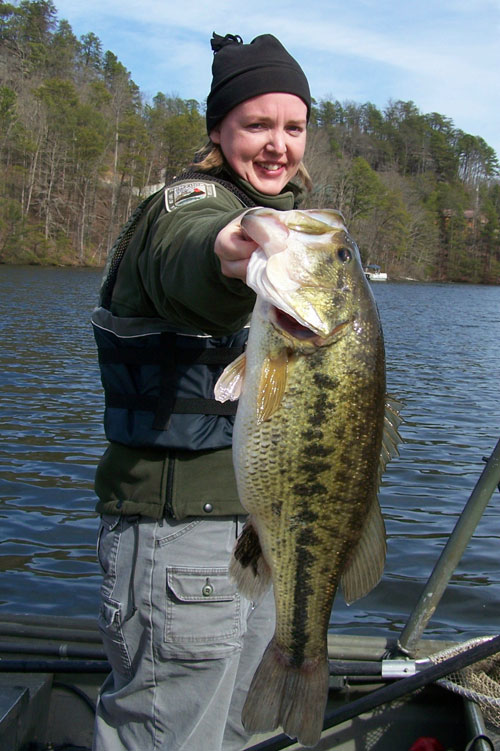BY Lee McClellan
It seems to Kentuckians that someone accidentally dropped the sun down a storm drain about three weeks ago and it hasn’t been found yet.

Day after day desolate gray skies discharged rain every few hours. Although it has been warmer than usual, this January has been a long slog.
February is the month tinges of hope arrive back in many anglers’ souls.
“Before any change of season, there are hints of the season to come,” said Mike Hardin, assistant director of Fisheries for the Kentucky Department of Fish and Wildlife Resources. “The change from late winter to spring is not abrupt. By the third week of February, you can hear spring peepers calling.”
This translates into a time when someone suffering from terminal stage cabin fever can catch a fish for the ages.
Warm February rains muddy the water and provide a temperature spike. “You get that good muddy water in mid- to late-February and you can pull some sows out of it,” Hardin said. “Females are gearing up for spawning. They need healthy fat reserves to get them through rigors of spawning. Instinct tells them they must eat.”
This situation is a fantastic time to catch a fat, pre-spawn female largemouth bass. Back in the day before graphite rods, bass boats or sonar units, gritty anglers would brave the weather during the first warm rains of February and employ the “jigging” technique to pull huge largemouth bass from shallow water.
They would use stout cane poles and a large hook tied to heavy black dacron line. These anglers would impale as many nightcrawlers as possible on the hook and using a skulling paddle for stealth, drop this combination beside any stump, log or other shoreline cover they could find.
Modern anglers can do the same thing with a ½-ounce black and blue jig and a flipping stick.
“That muddy water in late February is good flipping water,” Hardin said. “My uncle loved it when rains warmed the water to 51 degrees along the shoreline. He would flip a jig to the shoreline cover along those outside bends of Cave Run. That is when he caught his biggest largemouth bass. He had better weights in 51 degree water than in 70 degree water.”
Hardin said rains from the south in February also bring large muskellunge to the shoreline.
“That is when I first get my muskies,” said Hardin, who caught a 50-inch muskellunge from Cave Run Lake this past fall. “When you have a 42-to 48-degree main lake with warmer water coming in that is in the mid-50s, this is when you find fish along the shoreline.”
Some fish live suckers along the shoreline for big February muskellunge. Those anglers are strongly encouraged to employ a quick strike rig to prevent catch and release mortality. Large rattle baits, such as a muskellunge-sized Rat-L-Trap, also work well for shoreline muskellunge during this time of year.
“I also like a soft plastic bait called the Bulldawg in February,” Hardin said. “I like two-tone colors such as brown and orange. I also like the firetiger with a chartreuse tail version. I also throw jerkbaits like a Suick Thriller when they have their nose on the bank. They see that jerkbait work over their head and they hit it.”
A pronounced warm front in mid-to-late February draws big female smallmouth bass from their winter lairs into shallower water to feed heavily in lakes such as Lake Cumberland, Laurel River Lake, Dale Hollow Lake or the lower section of Green River Lake.
If warm rains accompanied the warm front, work white spinnerbaits with chrome Colorado blades right beside any submerged woody cover. This is an excellent presentation to catch huge smallmouths, especially if the water has some color to it.
If the warm front simply warms the top layer of water a degree or two without rain, big smallmouth will move up onto a flat to feed. The best flats lie adjacent to the channel on the main lake or major creek arm.
A medium-sized live shiner bottom fished in these areas is one of the best ways to catch the heaviest smallmouth bass of your life. Some anglers crawl the shiner slowly across the flat with just enough split shot weights to keep the shiner down. Others prefer still fishing shiners on the flat using a 1/4- to 3/8-ounce slip-sinker rig with a small black barrel swivel tied on the main line. An 18-inch leader of 8-pound test fluorocarbon line is tied on the other loop of the barrel swivel while the hook goes on the other end of the leader.
A size 1 Octopus-style hook works well for both presentations. You can also fish these rigs right in the middle of small cuts and tiny coves along the main lake or major creek arm for large February smallmouths.
“If you like catching big fish, February is a great month,” Hardin said. “A big fish warms you up better than a big coat.”
Remember to buy your fishing license soon. February 28 is the last day of the current license year in Kentucky.
Author Lee McClellan is a nationally award-winning associate editor for Kentucky Afield magazine, the official publication of the Kentucky Department of Fish and Wildlife Resources. He is a life-long hunter and angler, with a passion for smallmouth bass fishing.


Be the first to comment